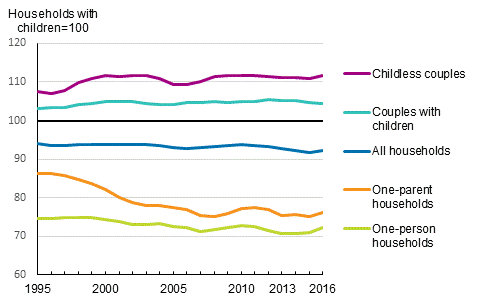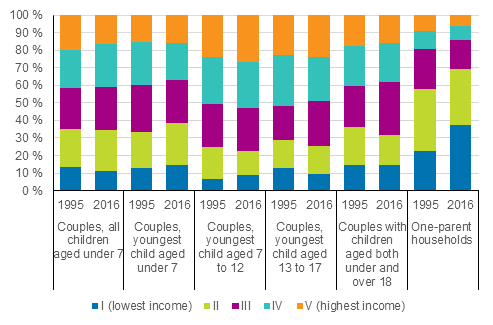Published: 23 March 2018
Economic situation of one-parent households has weakened
According to Statistics Finland's income distribution statistics, there were good 570,000 households with children in Finland in 2016, making up good one-fifth of all households. Households with children are placed fairly evenly in different income brackets in the income distribution. The position is weakest for one-parent households whose income is nowadays 75 per cent of the average for households with children. The relative position of one-parent households was clearly better in the mid-1990s than at the moment, when their income was 85 per cent of the income of all households with children.
Development of households’ relative income level by stage in family cycle in 1995 to 2016. Households with children, income =100

A household with children is a household including at least one child aged under 18. Income concept: equivalent disposable monetary income per household, median, three-year moving average. Equivalent income is the household's disposable income divided by the household's consumption unit figure.
Due to low annual income, 40 per cent of one-parent households is nowadays placed in the lowest-income quintile, while the share in the mid-1990s was only one-half of this, 20 per cent. Nowadays just five per cent of one-parent households are placed in the highest-income quintile, where their share was 10 per cent in the mid-1990s.
Two-parent households with children are placed clearly more evenly in different quintiles and their position in the income distribution has not changed much over the last 20 years.
Placement of households with children in quintiles in 1995 and 2016

Single-person households whose median income is now around 70 per cent of the income level of households with children are even worse off economically than one-parent households. By stage in family cycle, the situation is best for childless households formed by couples whose median income exceeds the income level of households with children by good 10 per cent.
The median for households’ equivalent disposable monetary income was around EUR 22,800 in 2016, while it was EUR 24,300 for households with children. In one-parent households the corresponding median income was EUR 18,300, while for couples whose youngest child was aged 7 to 12, it was EUR 27,500. For couples whose youngest child was aged 13 to 17, the median income was one thousand lower than this, EUR 26,550. The equivalent median income of childless couples was EUR 27,500, while it was EUR 18,000 in one-person households.
More detailed information on households’ income by population group can be found from the income distribution statistics’ database tables published in connection with this release.
The income data of the income distribution statistics do not take into consideration welfare services provided by society and financed by public funds, such as municipal day care or public health care services. These services are a significant economic advantage for lowest income households in particular, because they are either totally free for the recipients or the usage charges levied from them are clearly below the actual production costs of the service. In May 2018, Statistics Finland will release most recent data on the welfare services provided by society by population group based on the Household Budget Survey 2016.
Source: Income Distribution Statistics 2016, Statistics Finland
Inquiries: Pekka Ruotsalainen 029 551 2610
Director in charge: Jari Tarkoma
Publication in pdf-format (350.5 kB)
- Tables
-
Tables in databases
Pick the data you need into tables, view the data as graphs, or download the data for your use.
- Quality descriptions
-
- Quality report: Income Distribution Statistics (23.3.2018)
Updated 23.03.2018
Official Statistics of Finland (OSF):
Income distribution statistics [e-publication].
ISSN=1799-1331. Income differentials between population subgroups 2016. Helsinki: Statistics Finland [referred: 3.4.2025].
Access method: http://stat.fi/til/tjt/2016/02/tjt_2016_02_2018-03-23_tie_001_en.html

